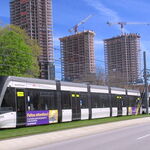I just noticed that not all of the all-stop Ottawa-Toronto trains stop in Smith Falls. Is this because of scheduling conflicts with CP due to the at grade crossover?
I'd have to guess which trains you mean with "all-stop Ottawa-Toronto trains", but almost all which somehow qualify already stop in SMTF (note that there are 12 intermediary stations between OTTW and TRTO: FALL, SMTF, BRKV, GANA, KGON, NAPN, BLVL, TRNJ, CBRG, PHOP, OSHA and GUIL):
In the regular schedule:
- Train 48 (TRTO@18:40, OTTW@23:16) stops at all 12 stations
- Train 643 (OTTW@08:40, TRTO@13:16) stops at 11 stations (no stop in GANA) [operates on Saturday and Sunday only]
- Train 54 (TRTO@17:40, OTTW@22:07) stops at 9 stations (no stop in GANA, BRKV and SMTF) [operates Monday to Friday]
- Train 59 (OTTW@18:26, TRTO@23:07) stops at 9 stations (no stop in GANA, NAPN and PHOP)
I assume you are referring to train 54, but that train is followed by train 48 which stops in SMTF and operates only one hour later.
That said, there have been indeed conflicts with CP about stops at SMTF, but these have been resolved by moving the station from the CP mainline to a new station in Montague (just one kilometer north). One scheduling constraint which remains at SMTF is that the station also doubles at a siding which doesn't have any platform access, which means that you need to ensure that there is plenty of time between two subsequent station stops (at least between trains running in opposite directions), to avoid that a late train causes two trains with scheduled station stop in SMTF reach the station at the same time...
It would be interesting to know what the traditional through ridership was through London, versus the transfer ridership. I wonder if ridership followed the changes in service, or vice versa.
I would expect that VIA would try to keep the maximum people in a single seat. Logically, with today's population that would imply some T-K-L-W runs.
I don't think this matters as TRTO will always remain orders of magnitudes more important as destination than any other station. If the northern and southern route offered comparable travel times, then the clear preference would be to route through train via the northern route, but as long as the time penalty is anywhere close to the full hour at present, it will always be the southern route...
You are correct, my concern is completely without supporting data.....except.....for the 1981 timetable you cited for Toronto-London. Where are all those trains today? Forty intervening years where VIA was trimmed back, and back again, is my point.
It's "use it or lose it": had VIA not been forced by budget cuts to cut frequencies in 1981, 1990 and 2012, I'd assume that VIA would still operate nine frequencies per day on the southern and five frequencies on the northern route, as every new timetable period is a process in which the previous timetable is the default new timetable and every change needs to be negotiated between VIA and the host railroad.
I'm sticking by my conspiracy theory. CN is remarkably accommodating of VIA east of Toronto, but that is very likely because they appreciate that a tribunal would not accept their desire to shed the sole passenger route that links Toronto, Ottawa, and Montreal. But when VIA has its own parallel route, and the question is serving the smaller communities rather than the main cities.....they may feel they have more leverage.
Compared to today, CN gains significant operational improvements on the Kingston Sub with HFR, as the VIA trains will decrease in frequency (by eliminating duplication between MTRL-TRTO and OTTW-TRTO frequencies), operate at slower average speeds (due to more stops) and have wider gaps inbetween them. At the same time it is difficult for a host railroad to retaliate against legal or political action taken by its tenant if that tenant has a corridor on which said host railroad doesn't control the dispatching. Also have a look at what is said
here about
Section 152 of the CTA:
Smith said Via did have some protections in legislation, before CN was privatized in 1995. At that point, all mention of passenger rail was removed from the act so it wouldn’t hinder CN being sold, Smith said.
“Sometime later I was successful in persuading people that we should put in section 152 (of the Canada Transportation Act,” Smith said. “It gives Via Rail the right to go to the Canadian Transportation Agency with complaints about service from the railway.”
But Via has only taken advantage of that once. Gormick said he understands why.
“(Via Rail complained about) CP when they didn’t want to honour an agreement about the number of trains going through a junction in Smiths Falls (Ontario). They took them to the CTA and Via Rail won,” Gormick said. “But they won’t do it with CN because 83 per cent of all their train miles are run on CN.”
Gormick said that Via Rail is concerned that if Via Rail complains to the CTA over one route, CN will retaliate.
I can't comment on VIA's relationship with CN (other than that it is already much more cooperative and constructive than certain "passenger rail advocates" let it appear), but I think we can agree that having a dedicated passenger corridor linking VIA's three busiest stations will alter the power relation with its most important host railroad...
And, I'm not confident that VIA has contractual language that would maintain the 100/95 mph top speed after HFR. Or prevent CN from taking some sections of double track out of service, particularly east of Brockville.
As far as I remember only P42 locomotives and LRC cars are allowed to reach 100 mph and there are hardly any corridor trains which are formed by just these two fleet types, but anyways, the more often Lakeshore services stop, the less the top speed would matter anyways, even if CN were to downgrade the tracks to Track Class four (i.e. 80 mph for passenger trains). Similarly, I don't see CN going down to single-track anywhere along the Kingston Sub, as it would be impossible to do so with drastic impacts on their own freight operations. Freight traffic on the Kingston Sub is much more intense than on the Winchester/Belleville Subs and than passenger traffic that eliminating some of the only 10-12 passenger trains per day between Brockville and Coteau will barely make a difference...
While CN runs plenty of freight on the Kingston line, they run higher volumes on the rest of their transcontinental network with plenty of single track. They will want full return on any excess capitalization that supports VIA.
Freight trains on the Kingston Sub are much shorter, faster and more frequent than out west - and I would expect CN to have very good reasons for operating in that way...
We can agree to differ on this.... a cheap bottle of wine bought today will have aged to perfection before we know. It's a safe wager

I don't mind having opinions, I'm just getting tired of unsubstantiated speculation presented as "this is going to happen"...
I may not have made that point well. VIA does a clever job of spreading local stops across its trains, such that a particular train stops only once or twice, thereby preserving the express timings and effectively giving the local stops "express" service. Post HFR, I imagine there will be few express timings. As already discussed, the timings will suffer. The question is, does that slower timing matter?
In absence of the necessity to serve the primary markets, which will shift the focus from aggressive trip times to increased connectivity between the various cities along the Lakeshore. Therefore, average speed will be lower, which will naturally decrease friction between passenger and freight operations (by decreasing their speed differential).
I'm strictly a guy in the bleachers, but I'm still hung up on trip time. Highway timings are highly variable with lots of horror stories.... but auto users have a funny way of remembering their best driving time and believing their next trip will be that good. VIA needs to provide service which is demonstrably faster than the auto, period, or the auto will prevail.
- Paul
HFR will be highly time-competitive against the car. As for the Lakeshore services, the issue is not travel time - it's the lack of reliability and frequencies (especially on the intermediary markets) and on both counts, post-HFR service will provide massive improvements which will easily outweigh the additional stops...
I have attached the speed/time and speed/distance graphs below. The recording was only started as the train left Gare Centrale on the viaduct but before it reached the Lachine canal.
View attachment 285938
View attachment 285939
As you can see, this travel time was achieved despite several slowdowns that could likely be removed with the ~150m dollars for this leg of HFR.
You can go on
Reservia and replace the train number and date (in the URL) with the journey for which you recorded the speed. Despite what you recorded, you can safely assume that your train never exceeded 100 mph (and probably not even 95 mph)...
By the way, you can always verify your (or any) train's current speed on TSI mobile:
Be informed of our departures and arrivals: follow your train in real time.

tsimobile.viarail.ca





